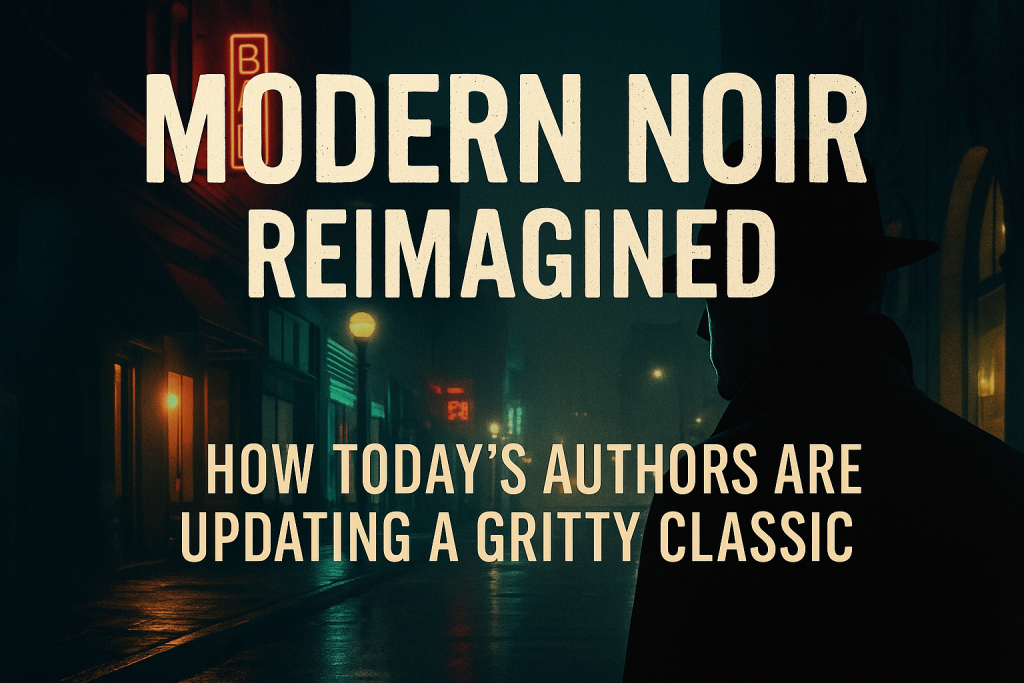Dark alleyways. Smoke curling in a detective’s office. Femme fatales with hidden motives and men on the edge of moral collapse. These are the hallmarks of classic noir fiction—and they still have a hold on readers’ imaginations.
But here’s the twist: classic noir isn’t dead. In fact, it’s being reborn.
Today’s writers are taking the core elements of the genre—grit, fatalism, moral complexity—and filtering them through new lenses: gender, culture, technology, and contemporary politics. The result? A new wave of modern noir that’s as sharp, shadowy, and cynical as ever—but with a fresh coat of blood-spattered paint.
Let’s dive into how authors are reimagining this iconic genre for a new generation of readers.
What Is Classic Noir?
Noir (French for “black”) emerged in the 1940s and 1950s as a gritty, cynical offshoot of hard-boiled detective fiction. Think Raymond Chandler, Dashiell Hammett, and James M. Cain—writers whose characters were often world-weary men navigating a corrupt society where justice was optional and trust was a liability.
Core features of classic noir include:
-
A morally ambiguous protagonist (often a PI or ex-cop)
-
A dark, urban setting
-
Fatalism and a sense of inevitable doom
-
Corruption, betrayal, and greed
-
Sharp, stylized dialogue
Classic noir was brutal, brilliant—and overwhelmingly male.
How Noir Is Being Reimagined Today
Modern noir keeps the bones of its predecessor but reshapes the flesh. The stories are still bleak, but they’re often personal. Today’s noir explores trauma, identity, and systemic injustice with the same grit—but more nuance.
1. New Faces, New Voices
Modern noir isn’t just white men in trench coats anymore. Authors are bringing in diverse voices—Black detectives, queer antiheroes, immigrant communities, and women with rage and reasons.
Read this:
-
S.A. Cosby’s Blacktop Wasteland and Razorblade Tears bring Southern grit, fast cars, and generational trauma into the spotlight.
-
Steph Cha’s Your House Will Pay is a brilliant L.A. noir that weaves racial tension into a revenge narrative.
2. New Settings, Same Grit
While classic noir was drenched in city grit—L.A., New York, Chicago—modern noir is branching out. From small-town corruption to sunlit suburbs masking darkness, location is still character, but it’s more flexible.
Read this:
-
Attica Locke’s Bluebird, Bluebird fuses East Texas heat with racial politics and classic crime structure.
-
Don Winslow’s The Border trilogy drapes noir storytelling over the cartel wars along the U.S.–Mexico border.
3. Tech and Psychological Twists
Modern noir plays with isolation, digital deception, and social commentary. Private eyes have smartphones. Villains might hide behind firewalls instead of smokey blinds.
Read this:
-
Flynn Berry’s Northern Spy uses psychological tension and modern espionage in a noir-soaked political thriller.
-
Denise Mina blends journalism and crime in Conviction, turning podcasts and public perception into noir devices.
Why Noir Still Matters
In an era of sanitized superheroes and cozy murders, noir offers something raw: truth. Noir dares to ask: What happens when good people make bad choices? When justice isn’t just? When survival means compromise?
It’s not always comfortable, but it’s real. And that’s why noir still resonates.
Hallmarks of Modern Noir
Want to write or spot great modern noir? Look for:
-
A flawed protagonist who isn’t out to save the world—just survive it
-
Moral ambiguity (no easy villains, no clear heroes)
-
Desperate stakes that feel grounded in today’s world
-
Dark, atmospheric tone—but not necessarily dated slang
-
Justice served… maybe. And if so, it comes at a cost
Modern Noir Must-Reads
Add these to your TBR pile for a crash course in how noir has evolved:
-
“Winter’s Bone” by Daniel Woodrell – Ozarks noir at its bleakest and most beautiful
-
“The Long Drop” by Denise Mina – True crime-inspired Glasgow noir
-
“IQ” by Joe Ide – A Sherlock Holmes-like sleuth in gritty South Central L.A.
-
“The Chain” by Adrian McKinty – Noir meets psychological suspense in a chilling kidnapping scheme
-
“The Last Place You Look” by Kristen Lepionka – A queer female PI brings new energy to the genre
Final Thought: Noir Never Dies—It Just Gets Smarter
The best thing about noir? It evolves. Like a foggy alleyway, it changes depending on how you approach it. What started as cynical detective stories has become a genre that interrogates our darkest instincts, deepest injustices, and most human flaws.
So whether you’re in it for the tough dialogue, the twisted characters, or the raw, aching truths—modern noir has something for you.
Light a metaphorical cigarette, crack open the door to a morally messy mystery, and let today’s noir show you how shadows still reveal the most interesting stories.


